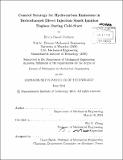Control strategy for hydrocarbon emissions in turbocharged direct injection spark ignition engines during cold-start
Author(s)
Cedrone, Kevin David
DownloadFull printable version (20.08Mb)
Other Contributors
Massachusetts Institute of Technology. Department of Mechanical Engineering.
Advisor
Wai K. Cheng.
Terms of use
Metadata
Show full item recordAbstract
Gasoline consumption and pollutant emissions from transportation are costly and have serious, demonstrated environmental and health impacts. Downsized, turbocharged direct-injection spark ignition (DISI) gasoline engines consume less fuel and achieve superior performance compared with conventional port fuel injected spark ignition (PFI-SI) engines. Although more efficient, turbocharged DISI engines have new emissions challenges during cold start. DISI fuel injection delivers more liquid fuel into the combustion chamber, increasing the emissions of unburned hydrocarbons. The turbocharger slows down activation (warm-up) of the catalytic exhaust after-treatment system. The objective of this research is to find a control strategy that: 1. Accelerates warm-up of the catalyst, and 2. Maintains low emissions of unburned hydrocarbons (UBHCs) during the catalyst warm-up process. This research includes a broad experimental survey of engine behaviour and emission response for a modern turbocharged DISI engine. The study focuses on the idle period during cold-start for which DISI engine emissions are worst. Engine experiments and simulations show that late and slow combustion lead to high exhaust gas temperatures and mass flow rate for fast warm-up. However, late and slow combustion increase the risk of partial-burn misfire. At the misfire limit for each parameter, the following conclusions are drawn: 1. Late ignition timing is the most effective way to increase exhaust enthalpy flow rate for fast catalyst warm-up. 2. By creating a favourable spatial fuel-air mixture stratification, split fuel injection can simultaneously retard and stabilize combustion to improve emissions and prevent partial-burn misfire. 3. Excessive trapped residuals from long valve overlap limit the potential for valve timing to reduce cold-start emissions. 4. Despite their more challenging evaporation characteristics, fuel blends with high ethanol content showed reasonable emissions behaviour and greater tolerance to late combustion than neat gasoline. 5. Higher exhaust back-pressure leads to high exhaust temperature during the exhaust stroke, leading to significantly more post-flame oxidation. 6. Post-flame oxidation in the combustion chamber and exhaust system play a critical role in decreasing the quantity of catalyst-in emissions due to hydrocarbons that escape primary (flame) combustion. A cold start strategy combining late ignition, 15% excess air, and high exhaust backpressure yielded the lowest cumulative hydrocarbon emissions during cold start.
Description
Thesis (Ph. D.)--Massachusetts Institute of Technology, Dept. of Mechanical Engineering, 2013. Cataloged from PDF version of thesis. Includes bibliographical references (p. 185-191).
Date issued
2013Department
Massachusetts Institute of Technology. Department of Mechanical EngineeringPublisher
Massachusetts Institute of Technology
Keywords
Mechanical Engineering.